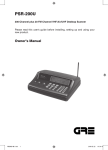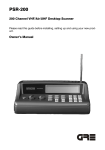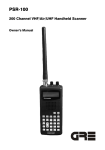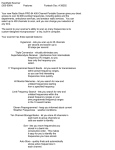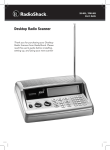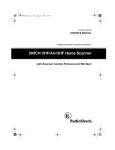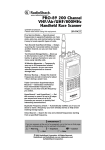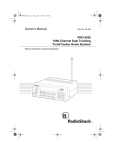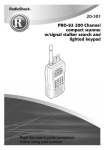Download Albrecht AE 100T Owner`s manual
Transcript
ALBRECHT AE100T 500-Channel Programmable Scanner OWNER’S MANUAL 1 INTRODUCTION The AE100T 500-Channel Programmed Scanner enables you to experience all the action for yourself. It is possible to store up to 115,000 frequencies in the memory. These can be changed at any time. The secret of the AE100T is a microprocessor which has been developed with this specific object in mind. This microprocessor provides the AE100T with, amongst other things, the following facilities: High Speed Scan -- lets you scan up to 40 channels per second and search up to 75 steps per seconds. Seek Scan/Search -- you hear transmission about 5 seconds, then the scanner start scan/search to the next transmission. Triple Conversion Superheterodyne Receiver -- virtually eliminates any interference from IF images, so you hear only the selected frequency. 23 Preprogrammed Search Bands -- lets you search for transmissions within preset frequency ranges, so you can find interesting frequencies more quickly. Ten Channel-Storage Banks -- let you store 50 channels in each bank to group channels so calls are easier to identify. Auto Store -- quickly finds and automatically stores active frequencies in each channel, then searches for additional active frequencies while skipping previously stored channels. Rotary Tuner -- lets you manually tune and select desired frequencies or channels. The scanner's tune speed automatically changes depending on how fast you turn the rotary tuner. 10-Priority Channels -- you can set the scanner to check 10 channels so you do not miss important calls. Two-Second Scan Delay -- delays scanning for about 2 seconds before moving to another channel or frequency, so you can hear more replies. Lock-Out Function -- lets you set your scanner to skip over specified channels or frequencies when scanning or searching. LCD Display -- makes it easy to view and change programming information. Backlit Display -- makes it easy to view and change programming information. 2 S-Meter -- shows receiving signal strength. Tape Remote Jack -- controls your tape recorder when the scanner receives the signal. Memory Backup -- keeps the channel frequencies stored in memory for about 3 months during a power loss. Two Power Options -- let you power the scanner from standard AC power ( with the supplied AC power cord), or your vehicle's battery (with an optional DC cigarette lighter power cord). Your AE100T scanner can receive all of these frequencies: l 25-1300 MHz SEARCH BANDS Your scanner can tune over 115,000 different frequencies. Each of these frequencies is contained within a group of frequencies called a band. The scanner uses permanent memory locations called search bands (01-23) to group these bands. You can search these bands to quickly find active frequencies you might want to store into the scanner's channels. The scanner has the following search bands Band 01 02 03 04 05 06 07 08 09 10 11 12 13 14 15 16 17 18 19 20 Search Range (MHz) 26-28 28-30 31-32 46-47 50-54 70-84 84-87.495 87.5-107.95 108-118 118-136.975 144-146 153-154 154-155 156-163 163-174 230-330 430-440 460-466 466-469 930-932 21 935-939 3 22 959-960 23 1240-1300 The use of this scanner is only authorised if the person concerned complies with all the provisions which apply within the country in which the scanner is used. You are advised to satisfy yourself that you are aware of the various restrictions which might apply within a particular country. At no time will your supplier be liable for the unlawful use of a scanner. PREPARATION This scanner is primarily designed for use in the home as a base station. You can place it on a desk, shelf, or table. Your scanner’s front feet fold up or down. Adjust them to give you the best view of the display. HOW TO AFFIX THE AERIAL SUPPLYED WITH THE SCANNER Screw the telescopic aerial supplied into the hole situated in the top right-hand corner of the scanner. The length of the aerial will affect the quality of the reception achieved by the scanner. For maximum reception, use the aerial as follows: 25-300 MHz: aerial should be fully extended 300-520 MHz: three sections of the aerial should be pulled out. 520-1300 MHz: aerial should be collapse all segments CONNECTING THE SCANNER TO AN OUTSIDE AERIAL (OPTIONAL) The telescopic aerial provided will normally be perfectly adequate for the purpose of receiving strong, local signals. In order to receive the weaker signals also, an outside aerial may be connected to the aerial connector situated at the rear of the AE100T. For this purpose, use a special scanner aerial – your supplier will be able to provide you with further information on this subject. Place the outside aerial on as high a location as possible, and assemble it in accordance with the instructions provided. To link the aerial to the scanner, use a 4 coaxial cable. For any distance of less than 15 meters, cable of the RG58 type may be used, whereas for longer cables the use of the thicker RG8 type is recommended. CONNECTING POWER Plug the scanner’s attached AC power cord into a standard AC outlet. The memory backup circuit begins to function a few minutes after you supply power to the scanner. How long the scanner will maintain channels stored in memory depends on how long power has been suplied to the scanner. For example, if power is supplied to the scanner for at least 4 days, the memory backup circuit maintains the channels stored in memory for up to 3 months. USING A DC ADAPTER You can power the scanner from your vehicle’s cigarette lighter socket, provided the vehicle has a 12-volt, negative-ground electrical system. To do so, you need a DC Adapter. Its centre tip must be set to positive (+), and it must have a plug that properly fits the scanner’s PWR jack. Using an adapter that does not meet these specifications could damage the scanner or the adapter. When you finish using the DC adapter, disconnect it from the cigarette lighter first. Then disconnect it from the scanner. RESTARTING/RESETTING THE SCANNER If the scanner has not been connected for some time, it may occur that the scanner fails to react to the keying in of certain commands; also, the display unit could appear not to be functioning normally. In such cases, the restart procedure needs to be carried out: 1. Switch on the scanner. 2. Use a pointed object – e.g. a straightened paper clip – to press the RESTART button which is located rear panel. If the scanner still does not work properly, you might have to reset it. If you reset the scanner, the information stored in the computer memory will be lost. Therfore take the utmost care when carrying out the following procedure: 1. Switch on the scanner. 5 2. Press and hold down the [CLEAR] button on the keyboard whilst pressing the RESTART button by means of a pointed object. First release the RESTART button, then release the [CLEAR] button. CONNECTING AN EXTERNAL SPEAKER You can connect an optional external speaker with a 3.5 mm plug to the scanner. Use an 8-ohm external speaker capable of handling over 2.5 watts of power (not supplied). Insert the speaker’s plug into the EXT SPKR jack on the back of the scanner. Note: Plugging in an external speaker disconnects the scanner’s internal speaker. CONNECTING HEADPHONES You can connect an optional pair of headphones with a 3.5 mm plug to the scanner. Use monaural headphones. Insert the headphone’s plug into the PHONE jack on the front of the scanner. Note: Plugging in headphones disconnects the scanner’s internal speaker. CONNECTING A TAPE RECORDER You can connect an optional tape recorder to your scanner to record transmissions. To record from the scanner, you need a tape recorder with a microphone jack. Also, you need a connecting cable with a phono plug and a 3.5 mm plug. 1. Insert the connecting cable’s phono plug into the TAPE OUT jack on the back of the scanner. 2. Connect the other end of the connecting cable to your tape recorder’s microphone jack. Follow the instructions provided with your tape recorder to record transmissions while the scanner is on. 6 UNDERSTANDING YOUR SCANNER A LOOK AT THE KEYPAD Your scanner's keys might seem confusing at first, but this information should help you understand each key's function. FUNC -- use the function key (REC, and DELAY) or seek scan/search. Number Keys -- each key has a single-digit label and a range of numbers. Use the digits on the keys to enter the numbers for a channel or a frequency. Use the range of numbers above the key (51-100, for example) to select the channels in a channelstorage bank. 7 DIRECT/• -- enters a decimal point (necessary when programming frequencies), or start a direct frequency search. ENTER -- enters frequencies into channels. PRI -- sets and turns on and off priority for ten priority channel. L/OUT -- lets you lock out selected channels or frequencies. L/O RVW -- lets you review locked-out channels or frequencies. CL/DELAY -- clears an incorrect entry. Or, programs a 2-second delay for the selected channel with FUNC key. LIMIT -- sets the frequency range you want to search. /\ /REC -- search up from the currently displayed frequency. Or, set the tape remote channel. \/ /SRCH -- searches down from the currently displayed frequency. MON -- accesses the 50 monitor memories. ATT -- turns attenuation on to reduce the scanner's sensitivity, or turns it off to increase it. BAND -- selects a preprogrammed search band. AUTO -- automatically programs frequencies into channels. AM/FM/WFM -- changes the receive mode. TUNE -- lets you use the scanner's rotary tuner to tune through frequencies. SCAN -- scans through the programmed channels. MAN -- stops scanning to let you directly enter a channel number. PGM -- programs frequencies into channels. OFF/VOLUME -- turns the scanner on or off and adjusts the volume. SQUELCH -- adjusts the scanner's sensitivity. TUNING Knob -- turn to tune through channels or frequencies. A LOOK AT THE REAR PANEL 8 ANT TAPE TAPE REMOTE OUT EXT SPKR DC13.8V RESET ANT -- connect optional antenna with BNC connector. TAPE REMOTE -- connect your tape recorder's remote terminal. TAPE OUT -- connect your tape recorder. EXT SPKR -- connect an optional external speaker. DC13.8V -- connect your vehicle's cigarret lighter socket with DC cigarette lighter power cable. RESET – reset the scanner. See “Resetting/Initializing the Scanner on page 12. A LOOK AT THE DISPLAY The display has indicators that show the scanner's current operation. A quick look at the display will help you understand how to operate your scanner. 9 SEARCH BANK -- appears with numbers (1-10). Numbers with a bar under them show which search banks are turned on for a limit search. BANK -- appears with numbers (1-10). Numbers with a bar under them show which channel-storage banks are turned on for scanning. P -- appears with numbers (1-10). Numbers with a bar under them show which priority channels are turned on. SCAN -- appears when you scan channels. MANUAL -- appears when you manually select a channel. /\ or \/ -- indicate the search or scan direction. L-OUT -- appears when you manually select a channel you locked-out while scanning. PGM -- appears while you program frequencies into the scanner's channels, or while you program limit search range. DELAY -- appears when you program a 2-second delay for a channel. PRI -- appears when the priority feature is turned on. AUTO -- appears when the scanner automatically stores frequencies into channels. TUNE -- appears when you press TUNE to use the scanner's rotary tuner. SEARCH -- appears during band, limit, and direct frequency search. MON -- appears with a number (1-50) to show which monitor memory you are listening to. 10 CH -- the digits that precede this indicator (1-500) show which channel the scanner is tuned to. AM/WFM -- appears when the scanner scans a frequency set to the AM, FM, or WFM mode, or flashes when you change a frequency to the AM, FM, or WFM mode. ATT -- appears when you turn on the scanner's attenuate feature. SIGNAL -- shows the receiving frequency's signal level with 8 dot. FUNC -- appears when you press FUNC key and use secondary function key. Display Message Error -- appears when you make an entry error. -dUPL- -- (duplicate) appears when you try to store a frequency that is already stored in another channel. CH-FULL -- appears when the all channel memories are entered while searching. L-FULL -- appears when you press L/OUT key while the scanner lockout 200 frequencies in search mode. A-FULL -- appears when you select a full bank while auto programming. Or appears when you finish sorting a full bank. AC-XX CH -- appears with a number to show the number of empty channels in a bank. Sor. -- appears when the scanner sorts frequencies. See "Sorting Frequencies Within A Bank" on Page 23. Pri-On -- appears when you press PRI key. PCH ALL-OFF -- appears when you press PRI key while scanner's all priority channels are empty or locked-out. rEcord -- appears when the scanner receives signal and record the transmission with tape recorder by tape recorder remort control function (see “Tape Recorder Remote Control” on Page 28). 11 OPERATION TURNING ON THE SCANNER/SETTING VOLUME AND SQUELCH Note: Make sure the scanner's antenna is connected before you turn it on. 1. Turn SQUELCH fully counterclockwise. 2. Turn VOLUME OFF/MAX clockwise until it clicks and you hear a hissing sound. 3. Turn SQUELCH clockwise, then leave it set to a point just after the hissing sound stops. The scanner automatically starts scanning channels. Press MANUAL to stop scanning. Notes: l If you have not stored frequencies into any channels (see "Searching For and Storing Active Frequencies" on Page 13), the scanner does not scan. l If the scanner picks up unwanted, partial, or very weak transmissions, turn SQUELCH clockwise to decrease the scanner's sensitivity to these signals. If you want to listen to a weak or distant station, turn SQUELCH counterclockwise. l If SQUELCH is adjusted so you always hear a hissing sound, the scanner does not scan properly. USING THE ROTARY TUNER The scanner's rotary tuner lets you quickly select channels and frequencies manually. As you turn TUNE one click, the channel or frequency changes one step at a time. Notes: l If you quickly turn TUNE, the rate at which the scanner tunes through the channels or frequencies becomes faster. l If you turn TUNE too slowly, the scanner might accidentally change the search or scan direction. Tuning Channel Numbers To tune channel numbers, press MAN, then turn TUNE clockwise (to tune to higher channel numbers) or counterclockwise (to tune to lower channel numbers). 12 Note: If you have not stored any frequencies into channels yet, the scanner displays the empty channels. Tuning Frequencies Note: You can use the rotary tuner to tune frequencies during a search (see "Searching For and Storing Active Frequencies" on page 13). Follow these steps to use the rotary tuner to tune frequencies. 1. When the scanner stops on a frequency while searching, press TUNE. The frequency number and TUNE appear. 2. To tune frequencies, turn TUNE clockwise (to tune to higher frequencies) or counterclockwise (to tune to lower frequencies). 3. To store that frequency in the channel, simply press ENTER. The scanner stores the frequency, and channel number appears. Note: When you store frequency while all channels are entered, CH FULL appears. In order to store more frequencies, you must clear some channels. See "Deleting Frequencies" on Page 19. 4. To store that frequency in the monitor memory, simply press MON. The scanner stores the frequency to monitor memory, and monitor memory number appears. RESETTING/INITIALIZING THE SCANNER If the scanner’s display locks up or does not work properly after you connect a power source, you might need to reset or initialize the scanner. CAUTION: If you have problems, first try to reset the scanner (see “Resetting the Scanner”). If that does not work, you can initialize the scanner (see “Initializing the Scanner”); however, this clears all information stored in your scanner’s memory. Resetting the Scanner 1. Turn off the scanner, then turn it on again. 2. Insert a pointed object, such as a straightened paper clip, into the reset opening at the back of the scanner and gently press then release the reset button inside the opening. Note: If the scanner still does not work properly, you might need to initialize the scanner (see “Initializing the Scanner”). 13 Initializing the Scanner Caution: This procedure clears all information you stored in the scanner’s memory. Initialize the scanner only when you are sure the scanner is not working properly. 1. Turn off the scanner, then turn it on again. 2. Press and hold CL/DELAY. 3. While holding down CL/DELAY, insert a pointed object, such as a straightened paper clip, into the reset opening at the back of the scanner and gently press then release the reset button inside the opening. 4. When the display reappears, release CL/DELAY. Note: You must release RESET before releasing CL/DELAY, otherwise the memory might not clear. SEARCHING FOR AND STORING ACTIVE FREQUENCIES You can store frequencies into channels using any of the following methods: l Manual storage l Auto storage l Each search operation l Tuning Operation l Moving a frequency from a monitor memory Manually Storing Frequencies If you know a frequency you want to store, you can store it manually. 1. Press PGM. PGM appears. 2. To select the channel where you want to store the frequency, use the number keys to enter the channel number, then press PGM. 3. Using the number keys, enter the frequency you want to store into that channel. 14 4. Press ENTER to store the frequency. Notes: l If you entered an invalid frequency in Step 3, the scanner beeps and displays the channel number and Error. Simply repeat Steps 3 and 4. l Your scanner automatically rounds the entered frequency down to the closest valid frequency. For example, if you try to enter a frequency of 151.473, your scanner accepts it as 151.470. l If you entered a frequency that is already stored in another channel, the scanner beeps three times and displays the lowest channel number where the frequency is already stored, and –dUPL– briefly flashes about three seconds. If you want to store the frequency anyway, press ENTER again. If you found mistake the frequency number after you press ENTER, you correct frequency number as follows: a. Press ENTER. One digit flushes. b. Move flushing digit by /\ or \/ key until the digit you want to correct. c. Press correct number with number key. Repeat steps 2 and 3 more correction. d. Press ENTER. 5. Repeat Steps 2-4 to store more frequencies into channels. Automatically Storing Frequencies Your scanner can automatically store active frequencies from a particular frequency range into empty channels in the banks specify. Notes: l The scanner automatically prevents storage of duplicate frequencies during auto store. However, you can manually store a duplicate frequency. l The scanner does not store locked-out frequencies during auto store (see "Locking Out Channels and Frequencies" on Page 25). 1. Press AUTO. AUTO and all scan banks appears. 2. Select scan bank where you do not want to store frequencies. The scanner displays the number of empty channels with AC-, Ch, at the flushed bar under bank number. 15 Notes: l To select bank 10, press 0. l If you select a bank that does not contain any empty channels, a bar flashes under the bank number, and A-FULL and AUTO appear. To enter new frequencies into this bank, you must delete one or more frequencies stored in it, then repeat Step 2. See "Deleting Frequencies" on Page 22. l If you want to select the bank, press the bank's number again. The bar under the bank appears. l If you select more than one bank and want to review the number of empty channels in each bank, press AUTO or turn TUNE knob to selected the bank you want to review. 3. Press LIMIT. L appears. 4. Use the number keys to enter the lower limit of the frequency range you want to search, then press ENTER. Note: If you enter an invalid frequency in Step 4 or 6, the scanner displays Error. Simply repeat the step. 5. Press LIMIT. H appears. 6. Use the number keys to enter the upper limit of the frequency range you want to search, then press ENTER. 7. Press /\ to search from the lower to the upper limit, or \/ to search from the upper to the lower limit. AUTO and the bar under the currently selected bank number flash on the display. When the scanner finds an active frequency, it stores the frequency in the displayed channel, then continues searching for more active frequencies, storing them in any subsequent empty channels. When the scanner fills all channels within the selected banks, the scanner beeps rapidly and displays the number of the last channel where a frequency was stored. Note: During auto store, you can manually change the receive mode. See "Changing the AM/FM/WFM Receive Mode" on Page 27. If you select WFM, the scanner searches frequencies at 50 kHz steps. 8. To pause auto store, press AUTO. The scanner displays the last channel number where a frequency was stored. To continue auto store, press /\ or \/. 9. To stop auto store, press MAN. MANUAL appears. 16 Notes: l If no frequencies are stored when you pause auto store by pressing AUTO, --appears on the display. l During auto store, the scanner beeps when the search reaches the upper limit frequency and continues searching at the lower limit frequency, or vice versa. Band Search If you do not know of a frequency to store, you can search your scanner's preprogrammed search bands for active frequencies, then store any that you find into your scanner's channels or monitor memories. Notes: l You can use the scanner's delay feature while using band search. See "Delay" on Page 25. l During band search, you can manually change the band mode. See "Changing the AM/FM/WFM Receive Mode." If you select WFM, the scanner searches frequencies at 50 kHz steps. Follow these steps to search for and store active frequencies using band search. 1. Press BAND. The last selected band number (b followed by a number, such as b02), SEARCH, and the associated frequency search range appear on the display. 2. To select a different band, enter the desired band number (01-23, see Page 3 for Search Bands) or repeatedly press BAND or turn TUNE knob until the desired band number appears on the display. Press and hold /\ for about a second to search from the lower to the upper band edge, or press and hold \/ for about a second to search from the upper to the lower band edge. /\ or \/ appears on the display. Notes: l To reverse the rapid search direction at any time, press and hold /\ or \/ for about 1 second. l To search the band upward or downward in small increments (in steps of 5, 12.5, 25, or 50 kHz, depending on the band), press and release /\ or \/. l To quickly move upward or downward through the range of frequencies, press and hold down /\ or \/. The scanner tunes through the frequencies until you release /\ or \/. 17 3. When the scanner find an active frequency, it stops searching and displays that frequency's number. To store that frequency in the channel, simply press ENTER. The scanner stores the frequency, then continue the searching. Note: When you store frequency while all channels are entered, CH FULL appears. In order to store more frequencies, you must clear some channels. See "Deleting Frequencies" on Page 22. 4. To store that frequency in the monitor memory, simply press MON. To search for another active frequency in the selected band, press and hold /\ or \/ for about a second, then repeat Steps 3 or 4. To select a different band then search for another active frequency, repeat Steps 2-4. Limit Search You can search for transmissions within a range of frequencies you select, called the limit search range. You can set and store up to ten limit search ranges into search banks (1-10). Notes: l You can use the scanner's delay feature while using limit search. See "Delay" on Page 22. l During the limit search, you can manually change the receive mode. See "Changing the AM/FM/WFM Receive Mode." If you select WFM, the scanner searches frequencies at 50 kHz steps. Follow these steps to set and store limit search ranges and search them for active frequencies. 1. Press PGM. PGM appears. 2. Using the number keys, select the number for the search bank where you want to store a limit search range. 3. Press LIMIT. SEARCH BANK, selected search bank number and L appear, and a bar flashes under the selected search bank's number. 18 4. Use the number keys to enter the lower limit of the frequency range you want to search, then press ENTER. Note: If you enter an invalid frequency in Step 4 or 6, the scanner displays Error. Simply repeat the step. 5. Press LIMIT. SEARCH BANK and H appears. 6. Use the number keys to enter the upper limit of the frequency range you want to search, then press ENTER. Repeat Steps 2-6 to store more limit search bank. 7. Press and hold /\ or \/ for about a second, to start search. As the scanner searches, it displays SEARCH, and the bar under the searching bank number flashes. Notes: l To reverse the rapid search direction at any time, press and hold /\ or \/ for about a second. l To search the selected band upward or downward in small increments (in steps of 5, 12.5, 25, or 50 kHz, depending on the band), press and release /\ or \/. l To quickly move upward or downward through the range of frequencies, press and hold down /\ or \/. The scanner tunes through the frequencies until you release /\ or \/. 8. Using the number keys, enter the search bank number for each limit search bank you want to select or remove. If you select more than 2 limit search bank, TUNE knob switches active limit search bank. 9. When the scanner find an active frequency, it stops scanning and displays that frequency's number. To store that frequency in the channel, simply press ENTER. The scanner stores the frequency, then continue the searching. Note: When you store frequency while all channel are entered, CH FULL appears. In order to store more frequencies, you must clear some channels. See "Deleting Frequencies" on Page 22. 10. To store that frequency in the monitor memory, simply press MON. To search for another active frequency, press and hold /\ or \/ for about a second, then repeat Step 8. 19 Direct Search You can search up or down from the currently displayed frequency and store frequencies you like into channels or monitor memories. Notes: l You can use the scanner's delay feature while using direct search. See "Delay" on Page 25. l During direct search, you can manually change the receive mode. See "Changing the AM/FM/WFM Receive Mode." If you select WFM, the scanner searches frequencies at 50 kHz steps. 1. Press MAN or PGM. 2. Use the number keys to enter the frequency you want to start the search from. Note: Do not omit digits (except the last zeros) after the decimal point. The frequency must be fully entered for the scanner to start the direct search. Or, use the number keys to enter the channel number containing the starting frequency and press MAN or PGM again. 3. Press DIRECT/•. -d-, and the starting frequency appear on the display. 4. Press and hold /\ or \/ for about a second to search up or down from the selected frequency. Notes: l To reverse the rapid search direction at any time, press and hold /\ or \/ for about a second. l To search the selected band upward or downward in small increments (in steps of 5, 12.5, 25, or 50 kHz, depending on the band), press and release /\ or \/. l To quickly move upward or downward through the range of frequencies, press and hold down /\ or \/. The scanner tunes through the frequencies until you release /\ or \/. 5. When the scanner find an active frequency, it stops scanning and displays that frequency's number. To store that frequency in the channel, simply press ENTER. The scanner stores the frequency, then continue the searching. 20 Note: When you store frequency while all channels entered, CH FULL appears. In order to store more frequencies, you must clear some channels. See "Deleting Frequencies" on Page 22. 6. To store that frequency in the monitor memory, simply press MON. To search for another active frequency in the selected band, press and hold /\ or \/ for about a second, then repeat Step 4. Tips for direct search You can search frequencies within the range of 1 to 10 MHz as follows: 1. Press MAN or PGM. 2. Use the number keys to enter the frequency you want to start the search from. Or, use the number keys to enter the channel number containing the starting frequency and press MAN or PGM again. 3. Press DIRECT/•. -d-, and the starting frequency appear on the display. 4. Select search range with numeral key (1-0). (One digit only.) Note: To select 10 MHz, press 0. 5. Press and hold /\ for about a second to search upward and loop the selected search range. Press and hold \/ for about a second to search downward and loop the selected search range. Notes: l If you set search range to over band edge frequency, the scanner searches to band edge frequency and return the start frequency. This search band range as "Introduction" on Page 2. l When the start frequency is set to the band edge frequency, if you try to search to the direction outside the band range, the scanner beeps and will not start searching. SCANNING THE CHANNELS 21 To begin scanning channels or to start scanning again after monitoring a specific channel, press SCAN. Notes: l You must store frequencies into channels before the scanner can scan them (see "Searching For and Storing Active Frequencies" on Page 13). l The scanner does not scan empty channels. The scanner scans through all channels (except those you have locked out) in the active banks (see "Locking Out Channels and Frequencies" on Page 25 and "Turning Channel-Storage Banks Off and On" on Page 21). To change the scanning direction, press /\ or \/. SEEK SCAN/SEARCH You can scan or search frequencies monitoring transmit about 5 second. After 5 second, the scanner start automatically scan/search to the next transmit. Seek Scan Follow these steps to seek scan on or off. 1. Press FUNC. FUNC flushes on the display about 5 seconds. 2. Press SCAN while FUNC flushes. Seek Search Follow these steps to seek search on or off. 1. Press FUNC. FUNC flushes on the display about 5 seconds. 2. Press BAND or LIMIT or DIRECT/• to enter each search mode while FUNC flushes. 3. Press /\ or \/ to start search. 22 TURNING CHANNEL-STORAGE BANKS OFF AND ON To turn off banks while scanning, press the bank's number key until the bar under the bank's number disappears. The scanner does not scan any of the channels within the banks you have turned off. Notes: l You cannot turn off all banks. There must be at least one active bank. l You can manually select any channel in a bank, even if the bank is turned off. To turn on banks while scanning, press the bank's number key until a bar appears under the bank's number. MOVING FREQUENCIES Moving a Frequency from a Monitor Memory to a Channel 1. Press PGM. 2. Use the number keys to enter the channel number where you want to store the monitor frequency, then press PGM. 3. Press MON. MON flashes. Use the number keys to enter the monitor memory's number (1-50), then press MON. MON flashes and the monitor memory's number and frequency appear. 4. Press ENTER. The scanner stores the frequency in the selected channel. 5. To move another monitor memory frequency to the next channel, press PGM and repeat Steps 3 and 4. Moving Frequencies from Monitor Memories to a Bank Your scanner can move all the frequencies you have stored in monitor memories into a bank you specify. Notes: l If there are more frequencies in the monitor memories than there are empty channels in the bank you select, the scanner moves only as many frequencies from the monitor memories as it has room for in the bank, leaving the remaining frequencies in the monitor memories. l The scanner programs monitor memory frequencies into channels even if the same frequencies are already programmed into other channels. 23 1. Press AUTO. AUTO appears. 2. Pressing AUTO key or turn TUNE knob, to select the channel bank where you want to store monitor memory frequencies. If you select a bank that contains at least one empty channel, a bar flashes under the bank number, and AC-, the number of empty channels in the bank, CH, and AUTO appears. Notes: l To select bank 10, press 0. l If you do not want to select the bank, press the bank's number key. If you select a bank that does not contain any empty channels, a bar flashes under the bank number, and A-FULL and AUTO appear. To store new frequencies into this bank, you must delete one or more frequencies stored in it, then repeat Step 2. See "Deleting Frequencies." 3. Press and hold down ENTER, then press MON. A bar flashes under the bank number, and AC-, the number of empty channels in the bank, CH, and AUTO appear. The scanner moves frequencies stored in monitor memories into the bank you specified in Step 2. Moving Frequencies from Banks to Monitor Memories You can move all stored frequencies within a bank to monitor memories. This lets you quickly clear channels within a bank without losing the frequencies. Caution: If you move frequencies from a bank to monitor memories, all frequencies already in the monitor memories are replaced with those frequencies and any empty channels from the bank. 1. Press AUTO. AUTO appears. 2. Pressing AUTO key or turn TUNE knob, to select the channel bank. 3. Press and hold down ENTER, then press DIRECT/•. The scanner automatically moves all frequencies in channels within the bank to monitor memories. DELETING FREQUENCIES Deleting a Frequency from a Channel or Monitor Memory 1. Press PGM. 24 2. Use the number keys to enter the channel number or monitor memory containing the frequency you want to delete. 3. If you are deleting the frequency in a channel, press PGM. If you are deleting the frequency in a monitor memory, press MON. 4. Press 0, then press ENTER. The frequency is deleted. Deleting Frequencies from All Locked-Out Channels Within a Bank You can delete the frequencies in all locked-out channels within a bank (see "Locking Out Channels and Frequencies" on Page 25). This lets you delete all the old or uninteresting frequencies in channels you have locked out. 1. Press AUTO. AUTO appears. 2. Pressing AUTO key or turn TUNE knob, to select the channel bank. 3. Press and hold down ENTER, then press L/OUT. Deleting Frequencies from All Channels Within a Bank You can delete the frequencies in all channels within a bank. This lets you quickly delete all frequencies from a bank if, for example, you want to use the bank to store a different category of frequencies. 1. Press AUTO. AUTO appears. 2. Pressing AUTO key or turn TUNE knob, to select the channel bank. 3. Press and hold down ENTER, then press CL/DELAY. SORTING FREQUENCIES WITHIN A BANK You can sort the frequencies you have stored within a bank. The scanner moves the frequencies into consecutive channels in numerical order, either from the lowest to the highest frequency, or the highest to the lowest frequency. This makes it easy for you to see the range of frequencies you found, for example, during auto store. Notes: l During frequency sort, the scanner moves the frequencies it finds within the bank from higher channels to lower, empty channels. l If you turn the scanner off during frequency sort, the scanner saves the portion of the sort it completed. 25 1. Press AUTO. AUTO appears. 2. Pressing AUTO keys or turn TUNE knob, to select the channel bank. 3. Press and hold down ENTER, then press /\ to sort channels from the lowest to the highest frequency, or press \/ to sort channels from the highest to the lowest frequency. As the scanner sorts the frequencies, Sor. appears on the display. USING MONITOR MEMORIES Monitor memories are temporary storage areas where you can store up to 50 frequencies while you decide whether or not to save them into channels. You can manually select monitor memories, but you cannot scan them. You can store frequencies you find during search operation, into monitor memories. Simply press MON when the desired frequency appears on the display. The channel number to the right of MON indicates the current monitor memory. To listen to a monitor memory, press MAN, then press MON. The current monitor memory appears. To select other monitor memories, use the number keys to enter the monitor memory's number (1-50), then press MON. Both MON and the frequency stored in the monitor memory are displayed. 26 SPECIAL FEATURES DELAY Many agencies use a two-way radio system that might have a pause of several seconds between a query and a reply. Your scanner's delay feature lets it wait for 2 seconds after each transmission on a channel or frequency while scanning or searching. To program a 2-second delay for a channel while scanning, manually select the channel and press FUNC then press DELAY/CL until DELAY appears. When your scanner stops on the channel, it waits for 2 seconds after each transmission on that channel before it resumes scanning. To program a 2-second delay for any active frequency while searching, press FUNC then press DELAY/CL until DELAY appears. When your scanner stops on a transmission, it waits for 2 seconds after each transmission on that frequency before it resumes searching. LOCKING OUT CHANNELS AND FREQUENCIES You can scan existing channels or search frequencies faster by locking out channels or frequencies that have a continuous transmission, such as a weather channel. To lock out a channel while scanning, press L/OUT when the scanner stops on the channel. To lock out a channel manually, manually select the channel and press L/OUT until L/O appears on the display. To remove the lockout from a channel, manually select the channel and press L/OUT until L/O disappears from the display. Notes: l You can delete the frequencies stored in locked-out channels within a bank. See "Deleting Frequencies from All Locked-Out Channels Within Bank" on Page 23. l You can still manually select locked-out channels. 27 To lock out a frequency during a each search mode, press L/OUT when the scanner stops on the frequency. The scanner locks out the frequency, then continues searching. Notes: l The scanner does not store locked-out frequencies during search. l You can lock out as many as 200 frequencies. If you try to lock out more than 200 frequencies, L-FULL appears on the display. Follow these steps to remove the lock-out from a frequency. 1. Press BAND or LIMIT or DIRECT/• to enter search operation. 2. Press L/O RVW. L-r appears on the display. 3. Repeatedly press /\ or \/ or turn TUNE knob until the frequency you want to remove the lockout from is displayed. 4. Press L/OUT. L/O disappears from the display. Reviewing Locked-Out Channels and Frequencies You can review the channels or frequencies you locked out. To review the channels you locked out, press MANUAL, then repeatedly press L/O RVW. As you press L/O RVW, the scanner displays all locked-out channels. To review the frequencies you locked out, press BAND or LIMIT or DIRECT/• to enter search operation, then press L/O RVW. As you press /\ or \/ or turn TUNE knob, the scanner displays all locked-out frequencies. Deleting All Locked-Out Frequencies You can delete all locked-out frequencies at one time. 1. Press BAND or LIMIT or DIRECT/• to enter search operation. 2. Press L/O RVW. 3. Press and hold down CL/DELAY, then press L/OUT. PRIORITY 28 With the priority feature, you can scan through programmed channels and still not miss an important or interesting call on a specific channel. You can program ten priority channel. Follow these steps to program the channels as the priority channel. 1. Press PGM. 2. To select the channel where you want to store the frequency, use the number keys to enter the priority channel number (1-10), then press PRI. 3. Using the number keys, enter the frequency you want to store into that channel. 4. Press ENTER to store the frequency. Notes: l If you entered an invalid frequency in Step 3, the scanner beeps and displays Error. Simply repeat Steps 3 and 4. l Your scanner automatically rounds the entered frequency down to the closest valid frequency. l If you entered a frequency that is already stored in another (normal) channel, the scanner beeps three times and displays the lowest channel number where the frequency is already stored, and dUPL briefly flashes. If you want to store the frequency anyway, press ENTER again. 5. Repeat Steps 2-4 to store more frequencies into priority channel (up to 10 channels). To turn on the priority feature, press PRI. The scanner checks the priority channel every 2 seconds. It stays on the channel if there is activity, and P with priority channel number appears. To turn off the priority feature, press PRI. PRI disappears from the display. Locking Out the Priority Channel You can lock out on or off priority channel. 1. Press PGM. 2. Press PRI. 3. Pressing PRI to select priority channel you locked out. 4. Press L/OUT. 29 CHANGING THE AM/FM/WFM RECEIVE MODE The scanner is preset to the most common AM/FM/WFM receive mode for each frequency range. The preset modes are: Frequency Band (MHz) Receive Mode 25.000-87.495 FM 87.500-107.950 WFM 108.000-136.975 AM 137.000-224.995 ` FM 225.000-399.9875 AM 400.000-1300.000 FM The preset mode is correct in most cases. However, some ham radio broadcasts do not operate in the preset mode. If you try to listen to a broadcast when the scanner is not set to the correct receive mode, the broadcast might sound weak or distorted. To change the mode, press AM/FM/WFM, AM, FM, or WFM blinks on the display to indicate that the displayed receive mode has been changed from the preset mode. Note: If you change any frequency band's receive mode during limit or direct search, the scanner no longer uses any of the preset receive modes. Instead, the scanner searches for frequencies in all the bands in the selected mode. To return to the default settings, press and hold down CL/DELAY, then press AM/FM/WFM. USING THE ATTENUATOR To reduce interference or noise caused by strong signals, you can reduce the scanner's sensitivity to these signals. Press ATT until ATT appears on the display to reduce the scanner's sensitivity. Note: If you turn on this feature, the scanner might not receive weak signals. To turn off the attenuator, press ATT again. ATT disappears from the display. TURNING THE KEY TONE ON AND OFF Each time you press any of the scanner's keys, the scanner sounds a tone. 30 Follow these steps to turn the scanner's key tone on or off. 1. If the scanner is on, turn VOLUME OFF/MAX counterclockwise until it clicks to turn it off. 2.While you press and hold down the 2 and ENTER keys, turn on the scanner. 3. After a second, release 2 and ENTER. TAPE RECORDER REMOTE CONTROL When you specify any channels (up to 10 channels) to receive signals, you can record them in the tape recorder by remote control. 1. Press MANUAL. 2. To select the channel where you want to select the tape remote channel, use the number keys to enter the channel number, then press MANUAL. 3. Press FUNC. FUNC flushes. 4. Press /\ /REC while FUNC flushes. rEcord and frequency will appears alternately. GENERAL HINTS Birdies The term “birdies” refers to noise signals which are generated by the electronics of the scanner itself. On certain frequencies, birdies are capable of interfering with, or even preventing, reception. Where the interference is of a mild nature, it may be possible to solve the problem by turning the SQUELCH control further to the right. If possible, use the following frequencies as little as possible. “Birdies” frequencies: will add RECEPTION 31 The distance over which it is possible for you to receive messages is restricted to approximately 25 km. The manner in which the scanner has been positioned will also be relevant here. It is preferable to position the scanner in such a way that the aerial has a “clear view”. In order to be able to receive transmitters located at distances beyond the aforementioned limit, the use of an outside aerial is recommended. FREQUENCY GRID The band division (frequency grid) – i.e. the distance between two frequencies lying next to each other – is different for each frequency band. Frequency Range Frequency Grid 25.000-87.495 MHz 87.500-107.950 MHz 108.000-136.975 MHz 137.000-143.995 MHz 144.000-146.000 MHz 146.005-224.995 MHz 5 kHz 50 kHz 225.000-1300.000 MHz 12.5 kHz 25 kHz 5 kHz 12.5 kHz 5 kHz This division is called the frequency grid. Where the frequency keyed in does not fit into this grid, the scanner will round down the frequency to the nearest value. MAINTENANCE AND USE The AE100T is a quality product and requires a minimum amount of maintenance. Carefully read the following instructions: . Do not expose the scanner to rain or moisture. . When using normal batteries, always replace weak batteries in one batch, and only replace them with new batteries. Where possible, use batteries which have a long life span. . Handle the scanner with care. Dropping it or subjecting it to rough treatment might damage its electronics. . Where necessary, clean the scanner with a damp cloth. Do not apply any cleaning fluids or solutions to it. 32 . Only use the scanner in normal temperature conditions. High temperatures, or sudden changes of temperature, will reduce the life span of the scanner. . Avoid the leaking of batteries by changing them at the appropriate time. Where possible, use rechargeable NiCad batteries. IN CASE OF FAULT Where a fault arises, contact your supplier. However, before you do so check that the fault was not caused by an operational error. Carefully reread the relevant section in the instructions. TECHNICAL DATA Frequency range: Freq. (MHz) 25-87.495 87.5-107.95 108-136.975 137-143.995 144-146 146.005-224.995 225-399.9875 400-1300 Channels of operation 5 50 25 5 12.5 5 12.5 12.5 Step (kHz) Mode NFM WFM AM NFM NFM NFM AM NFM 560 channels in any band combination 33 (500 channels per bank x 10 banks, 50 monitor memories and 10 priority channels) Sensitivity: NFM (S+N)/N=20 dB 25-500 MHz dev. 3 kHz at 1 kHz 500.0125-1000 MHz 1000.0125-1300 MHz AM (S+N)/N=20 dB 25-500 MHz mod. 60% at 1 kHz 500.0125-1000 MHz 1000.0125-1300 MHz WFM (S+N)/N=30 dB 25-500 MHz dev. 45 kHz at 1 kHz 500.0125-1000 MHz 1000.0125-1300 MHz 0.5 uV 1 uV 2 uV 2 uV 3 uV 5 uV 3 uV 3 uV 5 uV Selectivity: NFM AM WFM –6 dB –50 dB –6 dB –50 dB –6 dB –50 dB +/-10 kHz +/-20 kHz +/-6 kHz +/-12 kHz +/-150 kHz +/-300 kHz Scanning rate 40 channels/sec. Search rate 75 steps/sec. Scan delay time 2 sec. Priority sampling 2 sec. Intermediate frequencies: 1st 2nd 3rd 225.4125-225.5875 or 226.4125-226.5875 MHz 45 MHz 10.7 MHz or 455 kHz IF rejection: 612 MHz at 400 MHz 226.5 MHz at 760 MHz 45 MHz at 400 MHz 60 dB 70 dB 100 dB Squelch sensitivity: NFM and AM Threshold 25-500 MHz 500.0125-1000 MHz 1000.0125-1300 MHz Tight 25-500 MHz 0.5 uV 0.5 uV 3 uV 25 dB 34 500.0125-1000 MHz 1000.0125-1300 MHz 25 dB 25 dB Threshold 25-500 MHz 500.0125-1000 MHz 1000.0125-1300 MHz Tight 25-500 MHz 500.0125-1000 MHz 1000.0125-1300 MHz 3 uV 3 uV 15 uV 50 dB 50 dB 50 dB WFM Antenna impedance 50-ohms Audio output power (10% THD) 1.6 W (AC230V/50 Hz) Built-in speaker 77 mm, 8-ohm,dynamic type Power requirements AC DC 220-240 V, 50 Hz, 12 W 13.8 V, 400 mA Dimensions 232 x 210 x 90 mm (WDH) Weight approx. 2.0 kg without antenna 35




































